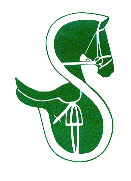 |
Sandridge Saddlery |
- Tack Talk - Saddle Pads |
Back to: Saddle Pads Archives |
 |
 |
 |
| Choosing a Saddle Pad Types of Pads |
| When used with well-fitting saddles, the principle benefit of a saddle pad is to protect the saddle from the horse's sweat and dirt. As not all saddles fit as well as we would like,
saddle pads become a way to cushion the back, distribute pressure, act as a shock-absorber and help with temperature regulation. Square Pads: The first choice of jumper and dressage riders, square pads are usually easier to fit and offer endless possibilities in colour, trims and embroidery. It is important that the profile, or 'spine', of the pad is well-shaped to avoid pressure on either the withers or at the back of the pad. Shaped Pads: Shaped pads are required for show hunters, but are also allowed for other disciplines. They cover less of the horse, so may be a little cooler than a square one. Pads from different manufacturers are cut slightly differently, so it may be necessary to try several to find one that fits the saddle well. Half-Pads: Half-pads are normally used as an additional layer between a regular saddle pad and the saddle. Sometimes they are strictly to provide extra cushioning, but they often have pockets in which shims of foam or gel are inserted to help improve the fit of a saddle, particulary if one saddle is used on many horses, or if a horse is changing in condition. Half-pads do reduce the contact between horse and rider. |
| Saddle Pad Materials |
| Cotton and Poly-cotton Quilting is lightweight and cool, but does absorb sweat and can get quite
wet when the horse is very hot. Coolmax are a series of moisture-wicking technical fabrics. The polyester fibres are engineered to draw moisture away from the skin and increase evaporation. Coolmax has a nice crisp appearance and is easy to care for and quick to dry. Synthetic Fleece is inexpensive, easy to care for and maintains a true white appearance. It is also hotter than natural fibers and doesn't offer the temperature-regulating benefits of wool. Sheepskin is expensive and must be maintained carefully, but it provides excellent cushioning, pressure distribution and temperature regulation. It is most effective when placed directly against the horse's skin, rather than over another pad. Wool is simply sheeps wool on a synthetic backing, making it easier to care for than sheepskin, but still providing the cushioning and temperature-regulating benefits. |
| Saddle Pad and Half-Pad Fill |
| Polyfill is lightweight and absorbent, but does not provide much in the way of cushioning or pressure distribution. Open-cell Foam is lightweight and airy, but 'bottom-outs' more quickly than most other types of foam. Provides light cushioning. Closed-cell Foam is usually included in thin layers of 3/4" or less. It is firmer than other foams, resisting pressure and helping to distribute weight. Closed-cell foam is impervious to water, and won't absorb sweat, but it doesn't breathe and can be hot. Memory Foam absorbs heat and becomes softer in use. Until it 'bottoms out', it is effective at cushioning, reducing shock and pressure points Gel is heavier than foam but doesn't trap as much heat. It is very good at deflecting shock, distributing weight and resisting twisting forces.. Felt is essentially dense wool. It is breathable and is particularly effective at weight distribution. |
| Fitting Saddle Pads | |
| Shaped Pads: Shaped pads should frame the saddle as precisely as possible, with 1 1/2 - 2" showing all around the saddle when it is pulled up into the gullet. It is also important that the pad doesn't shift in use - look for something with a non-slip material on the top-side against the saddle. |
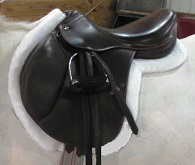 |
| Square Pads: Square pads offer a little more leeway in fitting, with anything from 2" - 3" showing all around the saddle being appropriate. Again, ensure it is pulled up into the gullet of the saddle, and use whichever fastenings (to the saddle D-rings or to the billets, and with the billets running through the loops at the base of the pad) are necessary to keep the pad anchored. |
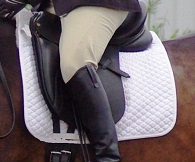 |
| Half-Pads: It is equally important to make sure a half-pad is correctly fitted. It should extend about 1 1/2" - 2" in front of and behind the saddle, be pulled up into the gullet of the saddle and most importantly, should NOT be longer than the underpad. When that happens (see second photo below at right), you will be creating pressure points under the saddle where the underpad ends. |
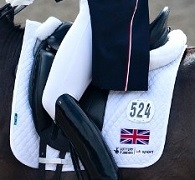 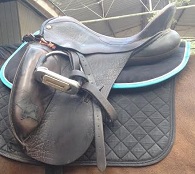 |
| General: A saddle pad that shifts (usually backward) is often the result of a saddle that does not fit particularly well. If different pads all bunch up or slide back, look into getting your saddle fit evaluated. | |
| Care of Saddle Pads |
| Cottons & Synthetics: Cotton quilt pads and synthetic fleece pads can be washed in the machine in warm water with a gentle detergent. To avoid shrinkage, either hang to dry or machine dry with low heat. Wool: Saddle pads with wool linings can also be machine washed in cold water on the gentle cycle with a soap designed for delicate fabrics. They should be hung to dry and the wool fluffed up by hand or with a stiff brush. Between washings, allow the pads to dry after riding with the wool side out and brush the wool before using it again to remove dirt and sweat and restore the pile. Sheepskin: Sheepskin pads are simply wool that is still on the leather skin. They should not be washed frequently as everytime the pad dries, the skin also dries out and becomes more fragile. Like wool-lined pads, sheepskin pads should be allowed to dry after use and then brushed to remove most of the dirt and sweat and to restore the pile. When washing is necessary, they can be put in the machine, gentle cycle, with a detergent designed for leather, suede, and delicate fabrics. Ten to fifteen minutes in the dryer on a 'no-heat' setting with a sheet of fabric softener seems to help keep the skin pliable; then hang the pad away from direct heat to finish drying. Neoprene and 'No-Slip' Pads: Neoprene pads can be brushed and/or hosed off to remove trapped hair, dirt and sweat and hung to dry, although it is normally safe to put them in the machine on a gentle cycle in warm water and then hang them to dry. ** The above are guidelines only - many pads come with washing instructions, and they should be followed for best results ** |
| "Tracey's Tackbox" - Saddle Pad Favourites | |
| Over the course of 4 decades of horse ownership and competitive riding, with more than 25 of them as a tack shop
owner, I have had the opportunity to test and evaluate MANY items of tack, equipment, and most of the supplement
and horse-care supplies on the market. The factors that go into the selection of a product or piece of equipment is the same for me as for all of you - there is a need, a budget, and often times, a size consideration - and after that it becomes a matter of personal preference. Over the years I have acquired particular items that have become what I consider essentials - favourites that, for a variety of reasons, I wouldn't do without. Here, without further ado, is a glance inside my tackroom at saddle pads... | |
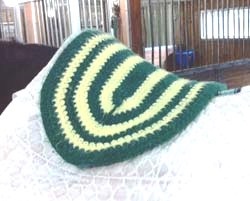 |
Knitted Wither Pad - I'll begin with this only because it's the oldest item on today's list. This is an item that isn't seen that often anymore, probably because there are so many other more modern, high-tech, or cheaper alternatives out there. I would also like to think that people pay more attention to correct saddle fit, resulting in less of a demand for this 'band-aid' solution. |
| They were once widely used on mostly Thoroughbred-type horses with high withers, on top of a regular saddle pad,
to give the saddle a little extra clearance in front. Mine is used only infrequently, for short periods of time when my
saddle needs a bit of a lift in front, but it is a simple and effective way for me to correctly balance my saddle while I
wait for Vicky to squeeze me into her busy schedule! My wither pad is in my stable colours of hunter green and yellow,
and is just the right thickness, size, and softness to do exactly what I need it to do. A classic. | |
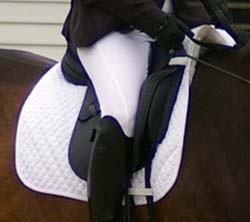 |
NuuMed Saddle Pads - Truth be told, I'm almost sick of these pads, and I when I see some of the new pads coming into the store in great colours, incorporating new fabrics and technical features, I am sorely tempted to put my stack of boring pads aside and spice up my life - but I can't. I use the SP01 - a square cotton-quilted pad with pure wool lining against the horse's back under the seat of the saddle only. |
| The sheepswool is not still on the (sheep's) skin, so the pads are easy to machine wash, yet the most important
benefits of sheepskin - temperature-regulation and pressure distribution - are maintained. I have recently added some with a Memory Foam layer which adds a little extra cushioning for the more Thoroughbred-type horse. The shape of the 'topline' of the pads prevent any wither pressure, or friction behind the saddle at the edge of the pad. The girth loops are correctly placed and the attachment to the D-rings on a dressage saddle (or billets on a jumping saddle) keep the pad from shifting, though only in competition do I even bother to use the attachments. My pads have lasted for years - I fluff up the wool with a currycomb or stiff brush before each ride and wash them about once every 4 or 5 rides. They look good, keep my horse's back comfortable, and last (and last...and last...) 'Nuf said. | |
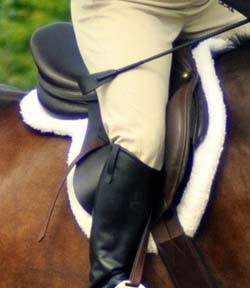 |
Non-Slip Hunter Pads - I love the look of a correctly-fitting shaped fleece pad, and HATE the look of one that is the wrong size, shape, or has slipped. The Ecogold Hunter pad is reserved strictly for showing, as I do find the heat builds up a bit underneath and they are not the easiest to keep in pristine condition despite being machine washable. These pads are really great for horses or ponies who are round in the body and on whom the saddle may shift a little from side-to-side, as the pad is non-slip on both sides and won`t slide around on the back of the horse. |
| The EquineLUX pad is non-slip on the surface only - preventing the pad moving underneath the saddle, but against
the horse`s back is a nice grey cotton fabric, which is a little cooler than the Ecogold, but doesn`t grip the horse`s back
the same way, making it better suited to horses whose saddles don`t slide around. The EquineLUX is also pricier, with a really nice quality trim around the edges. With either choice, once you put one on - they don't move! In fact, you need to make sure the saddle and pad are perfectly positioned when you tack up because THEY DON'T MOVE! I think George Morris would approve. | |
| Back to: Top of Page - Saddles - Archives |